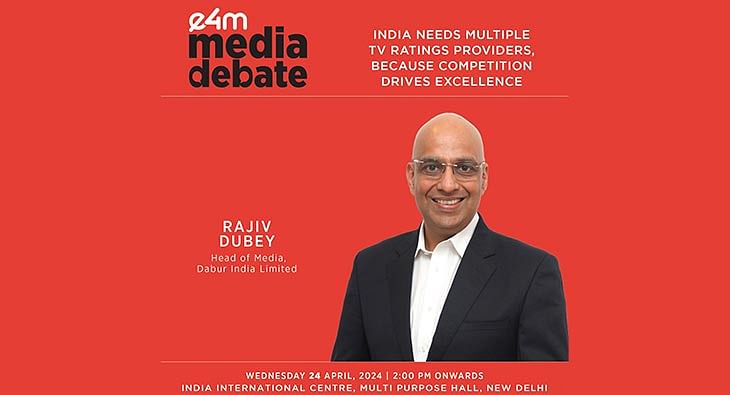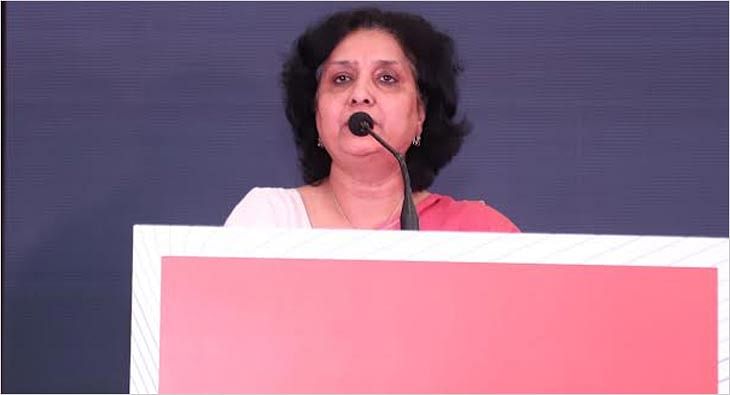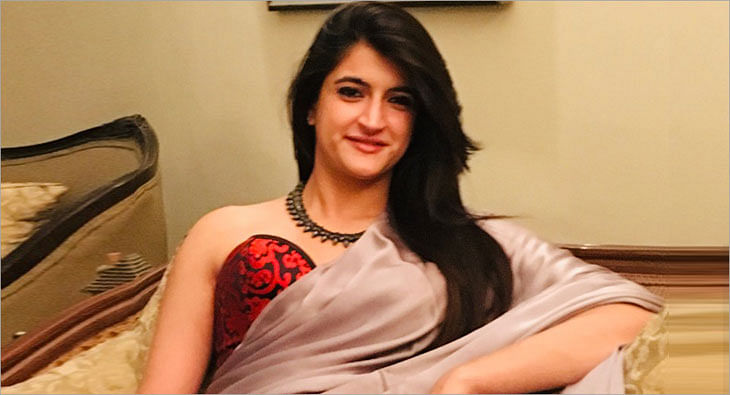Make in India and Show the World: Sudhanshu Vats
Viacom18 Group CEO and Chairman CII National Committee on M&E, Sudhanshu Vats gave the closing speech at the Media & Entertainment Seminar on the third day of Make in India which was also chaired by Colonel Rajyavardhan Singh Rathore, Sumit Mazumdar and Ramesh Sippy

Viacom18 Group CEO and Chairman CII National Committee on M&E, Sudhanshu Vats gave the closing speech at the Media & Entertainment Seminar on the third day of Make in India which was also chaired by Colonel Rajyavardhan Singh Rathore, Sumit Mazumdar and Ramesh Sippy
Excerpts from his speech:
Defining ‘Make in India’:
Sometimes we get carried away with the concept of ‘Make in India’ and think of it in terms of big machines, big companies and big resources. But Make in India is at the heart of every Indian, every individual. And it was actually interesting to see Shri Narendra Modi, our honorary Prime Minister, on Saturday, emphasising an integral point: Make in India is a program that is supposed to do two things. 1) It is supposed to generate jobs for our youth, and 2) Be a platform for our youth to become job enablers and entrepreneurs. It is in this context that Media and Entertainment fits beautifully. The ability of an Indian and everybody associated with the M&E industry to do that is fantastic. It is this concept I would want to build up on first.
The size of our industry is close to about 18-20 billion dollars. India boasts of the world’s 3rd largest TV audience, 2nd largest print circulation, largest film output and one of its largest Internet audiences. Yet, at ~17 Bn USD, our entire industry earns less than some of the world’s largest media conglomerates. The latest edition of the Star Wars franchise has already crossed over 1.5 Bn USD in global ticket sales, more than 2x of global collections (including gross domestic collections) of all Bollywood films in CY15.
Some will attribute this dichotomy to our content: is the comparison even valid? ‘Can we even think of matching the production budgets of global tent-pole properties?’ ‘Are our stories universal in a way that they appeal to the entire world?’ Others make references to economics to explain the chasm: in terms of purchasing power parity we are significantly greater than based on our ‘nominal revenues’. There is another lot (including myself) that looks at the regulatory framework for answers: shouldn’t pay TV pricing be completely deregulated if we want to deliver quality content? ‘We need addressability across India to ensure that the entire value chain gets its fair share of revenues.’
The Global Spotlight is here:
All these voices are acceptable, rational and attention-worthy. It might be prudent to point out that for our sector to attain escape velocity a deeper, more holistic view is required.
But I think the Make-in-India program has placed the (long overdue) global spotlight on India’s economic potential. And for the Media and Entertainment industry to realize its true potential, I would like to emphasise on what our honourable Prime Minister rightly described in his inaugural speech: The idea of the 4 Ds. Reiterating what he said, India is known for 3 Ds, which is Democracy, Demographic dividend & Demand. But now the time is to lay emphasis on the 4th D, which is deregulation.
For Indian firms to compete successfully, we need a light touch, consistent regulatory approach when it comes to our content, pricing and licensing- one that ensures parity across technology, platforms and jurisdictions. Multi-dimensional capacity building is the need of the hour. This theme has been repeated so often that it’s on the verge of becoming cliché. Yet that doesn’t take away from its relevance even today.
The Next Level of Growth:
If we truly want to transform this country into a global content powerhouse we need to invest in human capital and infrastructure. We employ around 5 Mn people today. We will easily need to double our workforce in the next 5-7 years to realise our goals. This includes talent from the creative, technical and management spheres. We need to invest in this talent pipeline today, if we are to reap the benefits in time. The industry needs to collaborate more with educational institutions, the government needs to facilitate these partnerships and parents and teachers need to create awareness and nurture interest in design, technology and creative skills at the level of primary education.
On the infrastructure side, while BharatNet is a commendable step, we need to expedite its rollout. Even today India has mobile-dark villages and some would argue that broadband speeds are too dismal to even be classified in the way that they are. Public Internet access is fast becoming a basic necessity in the lives of most Indians. Finally, infrastructure in the form of convention centres, stadia and venues for experiential entertainment needs to be built to support our industry. If we don’t get this piece right, the puzzle will remain incomplete.
What ails the M & E Sector:
Today, the M&E sector contributes to ~1% of India’s GDP, much lesser than its counterparts in developed economies. With time, as it grows in importance and scale, this contribution is bound to increase exponentially. The sector’s very inclusion in this flagship programme underscores its importance. Several policy measures under the aegis of the ‘Make-in-India’ programme are well intended. We are eagerly awaiting the new IPR policy, which is a much-needed intervention to ensure that our industry prospers. A steam-lined investment approval process and favourable foreign trade policy regime is bound to provide our sector with a fillip. The Make-In-India programme is a right step in the right direction. It has captured the imagination of people around the world, bolstered spirits within corporate and policy corridors and set the ball rolling for much-needed reform measures.
We power several ecosystems, beyond our own. As per press reports, over 18 Bn USD of investment proposals have been received in electronics manufacturing, particularly by mobile handset manufacturers. Have we ever stopped to ask about the utility of that awe–inspiring device with a 5-inch HD screen with 64GB storage and oodles of computing power if we don’t have high-quality, engaging video content? Media rights are the single largest contributor to almost all sporting leagues in this country. FMCG companies spend a significant portion of their top-line (~10-15%) on advertising because it contributes significantly to their growth. French islands and Turkish cities witness an increase in in-bound tourists after they’ve been featured in our films. We’re more than just us.
Conclusion:
The first thing is to continue the journey on deregulation. Keep it light with policies that are thought through. The second thing is in the area of IPR. And I think if the M& E industry has to grow further, we will need to have a very well-articulated IPR policy and the good thing is that the honourable Prime Minister himself spoke about this at the Make in India inauguration event.
We need to seamlessly blend technology and creativity. For that, we will need more physical infrastructure for us to be able to organise events that do so more regularly, more frequently and more safely. I think that is the third area where the impetus is on us for building better physical infrastructure.
My final point is in the area of building capacity from the point of view of multidisciplinary talents. Because ours in a converged world, I think it’s the combination of talent and management, talent and creative content, and talent and technology which will allow us to progress.
The M&E sector is a key pillar of the Make in India programme and is bound to gain from it, and gain it should. After all, when we ‘Make in India, For the World’, we also ‘Make in India and Show the World.
Read more news about Television Media, Digital Media, Advertising India, Marketing News, PR and Corporate Communication News
For more updates, be socially connected with us onInstagram, LinkedIn, Twitter, Facebook Youtube, Whatsapp & Google News
The current ratings system lacks trust: Rabindra Narayan, PTC Network
During the recently held e4m media debate, Rabindra Narayan, MD and President, PTC Network, spoke for the need for multiple TV rating providers
The current system of ratings by BARC lacks trust and credibility, said Rabindra Narayan, MD and President, PTC Network, at the e4m debate on Wednesday while asserting the need for multiple rating agencies in the broadcast ecosystem.
The e4m media debate on ‘India needs multiple TV rating providers because competition drives excellence’, held in New Delhi, was chaired by Anurag Batra, Founder of e4m and Editor-in-Chief of Businessworld Media Group.
During the debate, Narayan, who was speaking for the motion with other panellists, questioned the Broadcast Audience Research Council (BARC) ratings, particularly for news channels saying that politicians spending money to advertise on news channels and not GECs, is proof enough that the genre is doing much better than the ratings given by BARC.
“The fact that we are having this discussion, implies that the current system lacks trust. It lacks credibility. BARC analyses only linear TV that is beamed and received through satellite and cable. TV viewing today is not just linear TV, it also has several forms like connected TV and Fast TV coming on the same screen but BARC is not measuring it,” he said.
Narayan further said that it was time to innovate and look at content rating rather than just television rating points.
“As per BARC, news genre reach is 6-7% in the entire country, if that is true then why are politicians eager to spend on advertising on news channels? Why not on GECs? Why all the money spent by advertisers to reach maximum consumers, based on this Bible (BARC) which is junk? Why are we fighting for TV rating points and not content rating points when the technology and the system is changing?
“The current system of ratings (by BARC) is flawed, biased as it is controlled by a handful of people. Broadcaster lobby is controlled by four business houses so it will always remain in their favour. The data shows it,” he argued.
In his concluding remarks, Narayan said that BARC needs to improve and for that it does not even need to invest in more meters than it already has because cable operators and DTH are now digitised.
“They don’t even need to invest more. They don’t even need more meters than the ones installed already because every cable operator is now digitised and has two-way addressable communication available,” he said.
e4m Media Debate 2024: Call for multiple ratings agencies to break monopoly
Industry players discussed the authority of the current ratings system and whether having multiple agencies will cause increased complexities, discrepancies and expenses
Indian TV news media and advertisers today rely solely on the data released by the Broadcast Audience Research Council (BARC) India to strategise media plans and budgets.
Hence, many suggest having multiple rating systems which will allow for a more nuanced understanding of viewership patterns across different demographics.
Rabindra Narayan, MD and President, PTC Network; Mona Jain, Chief Revenue Officer, Zee Media, and Karthik Sharma, Group CEO, Omnicom Media Group believe a multi-ratings system will drive excellence amidst competition.
On the other hand, multiple ratings systems may also present challenges such as increased complexity, potential discrepancies in ratings, and higher costs for broadcasters as well as advertisers.
The current system of ratings is “flawed” and “biased, as it is controlled by a handful of people,” was the view of the industry veterans who advocated the need for multiple rating agencies instead of just one, which is currently the BARC, saying “monopoly makes people complacent”
During the debate, things got intense when some of the panellists, who were speaking for the motion, questioned BARC ratings, particularly for news channels saying that politicians spending money to advertise on news channels and not GECs, is proof enough that the genre is doing much better than the ratings given by BARC.
To present a viewpoint against the motion, Chintamani Rao, Strategic Marketing and Media Consultant, Rajiv Dubey, Head of Media, Dabur India, and Varun Kohli, Director and CEO, Bharat Express News Network joined the debate at e4m’s Media Debate in New Delhi. Dr. Annurag Batra, Chairman and Editor-in-Chief, BW Businessworld Media Group and Founder, e4m Group, chaired the debate.
Jain opened the discussion and said, “There is a dependency of an advertiser to take up a particular media plan via the agency. On the other hand, the broadcaster is absolutely at the mercy of the measurement system which decides where you rank. The issue is nobody looks at what the reality on ground is. Hence, I have started telling agencies and advertisers to also look at my digital platform’s ranking but the rating in BARC still holds significant value for them.”
She further suggested we should have an authenticated, validated, acknowledged currency which is recognised and valued by advertisers and agencies as well.
Presenting an opposing stand, Rao explained, “There many doubts about BARC and its functioning but I continue to maintain that audience measurement is no business of the government.”
At the end of the day, it is not about the number of vendors but how they are managed. Two poorly managed are not better than one, he added. The key issue is that BARC is dominated by one of its constituents and that is the one which is being measured.
“If advertiser’s money fuels the entire media ecosystem, why did they accept a structure with Indian Broadcasting & Digital Foundation (IBDF) at 60 percent?” questioned Rao.
Sharma, who joined virtually, expressed that if we forget the industry for a while, why do we need the NSE and BSE? Why do we need CIBIL and Experian? The short answer is innovation and competition. If there would be no competition, we would have one brand in every category we operate in.
“Even in a market like the USA, which has the largest AdEx market, there are two systems. Even the UK, Australia, Malaysia, Philippines and so many more countries have two audience measurement systems. In a largely populated country like India two systems will help in better sampling and segmentation,” he added.
Dubey took the stage right after and spoke about how one, two or multiple rating systems don’t matter to an advertiser. At the end of the day, it should help the brand sell. His objective is to reach out to the consumers in the cheapest possible manner.
“The idea of BARC was to have a robust system which could measure everyone well. Have we been able to do that? Probably yes or probably no,” he said.
With changing times, the audience needs have changed and NCCS was a system that measured the class of people based on the ownership of consumer durables. But now, the newly proposed ISEC fulfils those gaps.
Consumers have also started consuming content on different platforms, more towards digital and OTT. Dubey believes, “We haven’t been able to measure that audience correctly yet. Hence, the Indian TV industry needs one system and that system needs to be strengthened in such a way that it measures TV and digital audience equally.”
On having multiple audience measurement systems, the Dabur spokesperson said, “To solve the problem, you should not create another problem, but fix the problem instead.”
Narayan of PTC, who stood for the motion, expressed, “The fact that we are standing here and debating the issue, implies the current system lacks trust and credibility. We are also setting the premise that by TV ratings, we only mean linear TV ratings because that is what BARC does.”
He further shared that BARC does measurement via image mapping and hence, when any channel puts its watermark on any platform, it should become measurable for BARC since they already have the technology for it.
“Then why don't they? Because they need more focus on analysis, not more investment. The trouble is the ecosystem is not allowing the expansion of those ratings,” he added.
Today, BARC says 9 out of 100 people watch PTC, which is impossible and advertisers bargain for the ad rates accordingly. The channel today continues to invest in good shows but advertiser interest is low due to BARC’s data. If there is any truth to this, why wouldn’t players like PTC fight for multiple ratings systems?
“When Chandrayaan was launched, everyone in the world and India was watching it but if you see the BARC data, that particular week the ratings of the news genre went down. Is that even possible? News genre is much higher than what BARC is projecting,” Jain added.
Even on a day like the launch of Chandrayan, there was no spike on BARC data. Jain and Narayan both believe the current system is flawed and biased because it is controlled by a handful of people.
“The fact that we are having this discussion, implies that the current system lacks trust. It lacks credibility. BARC analyses only linear tv that is beamed and received through satellite and cable. TV viewing today is not just linear tv, it also has several forms like connected TV and Fast TV coming on the same screen but BARC is not measuring it,” Narayan said.
Narayan further said that it was time to innovate and look at content rating rather than just television rating points.
“As per BARC, news genre reach is 6-7% in the entire country, if that is true then why are politicians eager to spend on advertising on news channels? Why not on GECs? Why all the money spent by advertisers to reach maximum consumers, based on this Bible (BARC) which is junk? Why are we fighting for TV rating points and not content rating points when the technology and the system is changing?
“The current system of ratings (by BARC) is flawed, biased as it is controlled by a handful of people. Broadcaster lobby is controlled by four business houses so it will always remain in their favour. The data shows it,” he argued.
Kohli of Bharat Express, said, “BARC came into existence because publishers wanted a different rating system and then a mechanism was conceived. Now, questioning that system just because ratings aren’t in the right proportion or it doesn’t map digital audiences and to further ask for a separate body, I dont think is the right way.”
The industry needs to come together and exercise jurisdiction with BARC to tell them what more is needed and where they can get better, he suggested as a solution.
Rao also suggested it is better to have an aggregator rather than multiple players. In that case, the aggregator can also become the provider of data. BARC can always collect multiple data from various sources and present it.
The mapping of the audience correctly will also solve the problem in a way, which will be done with ISEC majorly. Having a unified measurement is also another solution, said Dubey.
According to Sharma, “Having more than one player will definitely fuel innovation and have a little competition, which is good. Different rating systems could also focus on different target segments, cohorts and more.”
“We need to focus on screens and not linear tv or digital. It is a screen-based world and people are just consuming content which is meaningful for them. So different types of consumptions require different types of measurements. My argument is innovation is critical as it is high time.
“Consumer is looking at the screen through mobile or TV sets. How are we measuring it? Some competition is healthy. It is important to have a mindset of how one system can help the other. The current system is not wrong but the newer system can enhance what we have,” he said.
Narayan concluded, “Television viewing and consumption has changed. Either BARC grows up to the changing times or others should come in and fill the gap. The market forces will decide who will remain and who will go, whose data is authentic and whose is not. There is no need for a debate here.”












 Share
Share